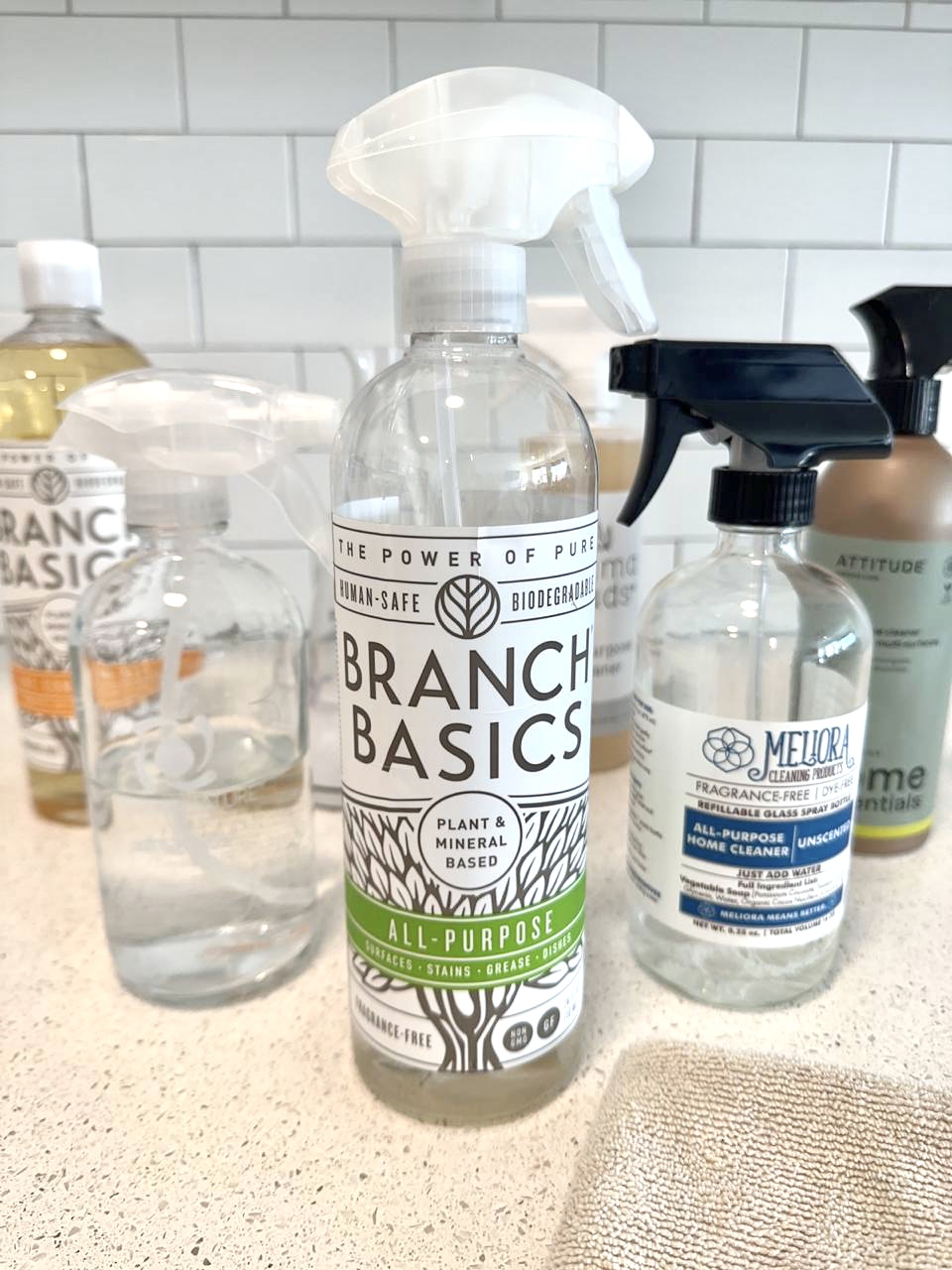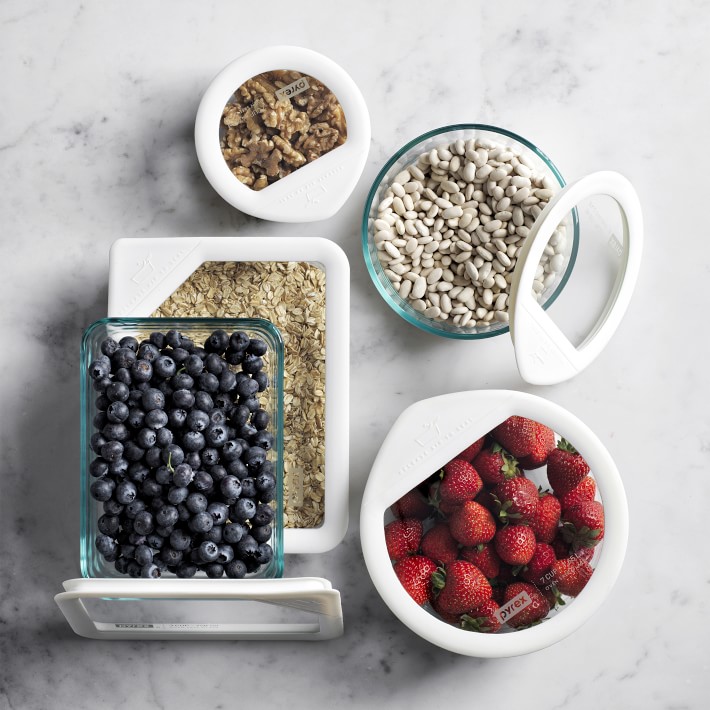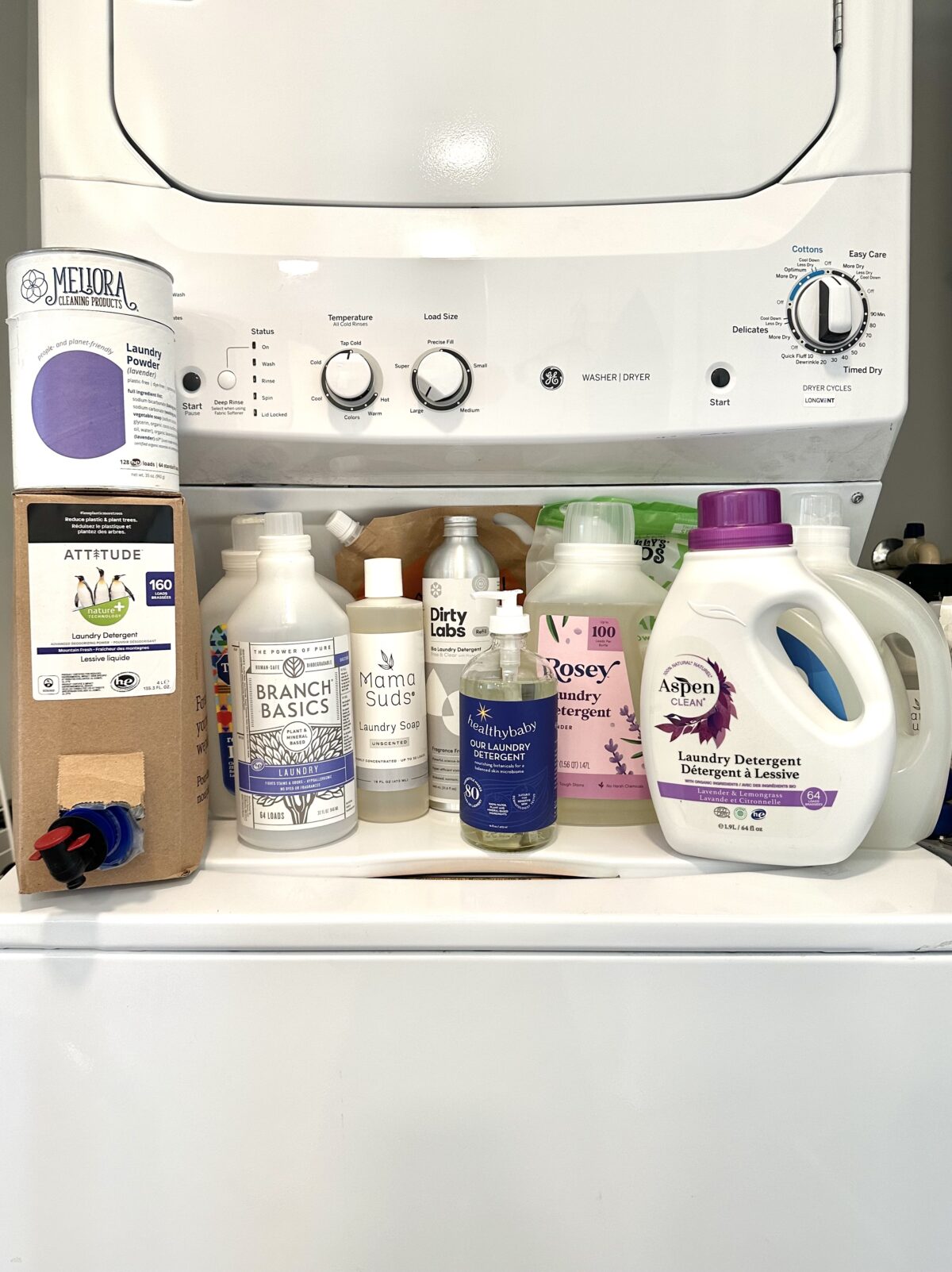For many of us, our homes are our sanctuaries—safe places where we can retreat from an increasingly unpredictable world. But some common household items may be putting your health at risk. Learn about the most dangerous things in your house and how best to manage the risks.
Table of Contents
- 1. Prescription medications
- 2. Non-stick cookware
- 3. Corrosive cleaning products in your kitchen and bathroom
- 4. Plastic food storage containers
- 5. Air fresheners and perfumed candles
- 6. Hand and body soaps
- 7. Cosmetics
- 8. Laundry detergent
- 9. Sofas and mattresses with flame retardants and PFAS
- 10. Paint, stains, and finishes
- 11. Antifreeze
This article contains affiliate links, which means we may earn commission if you decide to make a purchase.
1. Prescription medications
Why: Medicines save lives, so it may surprise you that we put them at the top of this list. This is because the majority of US adults use prescription medication, but when taken in the wrong dosage or by the wrong person, they can cause addiction, injury, or death.
- Many children are hospitalized each year from accidental poisoning by prescription medication.
- Older adults managing complex medication regimens are also at risk for accidental poisoning.
- Health experts estimate that 6% of the US teen and adult population uses prescription drugs for non-medical reasons in a given year and that 12% of these prescription drug users are addicted.
- Prescription medication metabolites are not easily filtered out by municipal water treatment facilities and end up in our drinking water, further endangering our health.
How to keep children safe:
- Keep medications on a high shelf.
- Use child-resistant closures on all medicines.
- Avoid taking medications in the presence of children, as children imitate their caregivers.
- Don’t refer to medications as “candy.”
How to keep yourself and your family members safe:
- Maintain a regular schedule for taking prescription medication.
- Keep a journal noting times when medications are taken and their dosages.
- Get all medications from a single pharmacy to reduce the risk of interactions.
What to do about pharmaceuticals in drinking water: Consider installing a high-quality water filter, such as a reverse osmosis filtration system. Reverse osmosis is more powerful than carbon filtration, removing up to 99.9% of pharmaceuticals and other contaminants.
2. Non-stick cookware
Non-stick cookware makes cleaning up after dinner a whole lot easier, but its slippery coatings usually contain per- and polyfluoroalkyl substances (PFAS for short).
While the FDA still allows PFAS to be used in non-stick cookware, they are endocrine-disrupting chemicals (EDCs) that have been linked to reduced immune function, cancer, and other health concerns.
What’s more, the chemicals can enter water systems and lead to widespread contamination of the natural environment, as they never break down. This is why PFAS are often referred to as “forever chemicals.”
How to protect yourself:
- If you already own non-stick cookware and can’t afford safer pots and pans at this time, only use your existing cookware at lower temperatures. Try to stick to cookware that’s not chipped. Additionally, remember to ventilate the cooking area, as PFAS may be released from non-stick coatings and into the air when they’re overheated.
- Use wooden cooking utensils to avoid scratching cookware surfaces, which can disrupt the coatings and release even more of the chemicals.
- Better yet, opt for ceramic, stainless steel, or cast-iron cookware, which are naturally non-stick. To help you choose which kind is best for your household, you can read more about non-toxic, PFAS-free cookware here.
Home
How to Choose the Best Non-Toxic Cookware (2024)
There may not be a 100% *perfect* kind of non-toxic cookware, but this guide will help you figure out the best fit for you based on your needs and preferences.
3. Corrosive cleaning products in your kitchen and bathroom
Everyone loves a sparkling clean home, but you shouldn’t endanger your health to get there. The strong chemicals in traditional cleaning products for ovens, drains, and toilet bowls are overkill and among the most dangerous substances in your home, as they rely on caustic chemicals like bleach, ammonia, hydrochloric acid, and phosphates for their corrosive action.
- The vapors from these products can cause severe respiratory and eye irritation during use if the area being cleaned isn’t properly ventilated.
- The products can cause irritation or burns upon direct contact with the skin, and splashes into the eyes can even cause blindness.
- The products are highly poisonous if ingested, making them especially dangerous to have around if you have small children.
- Last but certainly not least, mixing some of these chemicals (e.g., bleach and ammonia) releases poisonous fumes that can be deadly upon inhalation.
You don’t need toxic chemicals to maintain a clean home. Try these things instead:
- Warm water and plain soap often get the job done.
- Try white vinegar solutions and sprays: one part water to one part vinegar.
- Use baking soda when you need scrubbing action.
You can also try natural cleaning products, but become an informed consumer to avoid being fooled by greenwashing for products labeled “natural” or “non-toxic.”
Home
My 4 Favorite Brands for Non-Toxic Cleaning Products
Research shows cleaning products can contribute significantly to indoor air pollution. Here are the best non-toxic cleaning products (in my opinion!) to try in your home.
4. Plastic food storage containers
It may be time to toss that old Tupperware. Plastic food containers (especially older ones) may contain bisphenol A (BPA). BPA (and other bisphenols) are associated with infertility, altered fetal growth, ADHD, polycystic ovarian syndrome, endometriosis, heart disease, and more.
How to keep yourself safe:
- Transfer food from plastic containers to a glass dish before microwaving.
- When you can avoid it, do not put plastic containers in the dishwasher or scrub them with a rough brush. Doing so may cause microtears, which can increase leaching of toxicants.
- Discard any damaged or discolored plastic containers, which are more likely to leach plastic chemicals into food.
- Check out this Filtery article on safe, plastic, and non-toxic food storage containers.
Home
Safe, Plastic-Free, & Non-Toxic Food Storage Containers for 2024
Want to switch to plastic-free food storage containers?! Learn about why toxins in food storage may be damaging your health and which non-toxic food storage containers to use instead.
5. Air fresheners and perfumed candles
Fragrance chemicals
A vanilla candle or citrusy air freshener can make a stale room much more inviting. But it may contain a range of potentially toxic chemicals, including endocrine disrupting chemicals (like phthalates), carcinogens (such as formaldehyde and benzene), volatile organic compounds (VOCs), and other substances known to have adverse health effects.
VOCs can greatly reduce the quality of indoor air and can cause headaches, eye irritation, hormone disruption, and more. They can also exacerbate pre-existing conditions like asthma.
In addition to VOCs, scented products may contain musk ketones and semi-volatile organic compounds (SVOCs) such as phthalates, which are EDCs that can contribute to ovarian failure and sperm dysfunction.
How to protect yourself:
Fragrance formulas are considered trade secrets, meaning that companies aren’t required to disclose the full list of ingredients in the formula. For this reason, you should adequately ventilate your home when using any artificially scented product, regardless of the information on the label. We recommend
When possible, use naturally scented alternatives such as:
- Essential oils (Although, be aware that even essential oils can emit VOCs. Some people can have allergic reactions to certain essential oils. Make sure you’re purchasing from a reputable manufacturer that is sourcing carefully and not using extra fillers.)
- Pomander balls (oranges studded with cloves)
- Potpourri (try making it yourself!)
- Fragrant house plants such as lavender, mint, begonia, or orchids
For more ideas on how to freshen the air in your home without compromising your health, check out these Filtery articles on non-toxic air fresheners and plug-in air fresheners.
Home
7 Febreze Alternatives! Non-Toxic Air Fresheners & Organic Room Sprays (2024)
Everyone loves a fresh-smelling home, car, gym bag, and bathroom. Here are the best organic and non-toxic air freshener sprays to use instead of Febreze!
6. Hand and body soaps
Fragrance chemicals
Scented soaps contain fragrance chemicals such as VOCs and phthalates, which can be hazardous when inhaled, as described earlier. Some synthetic chemicals can also bother the skin, especially if you have a pre-existing condition like acne, eczema, or rosacea.
Parabens
Some soaps contain parabens, which are preservatives that inhibit bacteria and mold growth. But parabens are known EDCs that mimic the effects of estrogen in the body. These endocrine effects may be particularly harmful during fetal and early childhood development, when organ systems are still forming. In response to the growing body of evidence on the health risks of parabens for infants, children, and adults, the EU has already taken steps to ban or limit them in soaps and other personal care products.
Sulfates
Other potentially problematic ingredients are sulfates—sodium lauryl sulfate (SLS) and sodium laureth sulfate (SLES)—which are responsible for the foaming action in soaps, shampoos, and detergents. While these chemicals can help remove dirt and grime from our skin’s surface (and create nice bubble baths), they can be highly irritating to the skin and eyes.
How to protect yourself:
- Instead of liquid soaps, use bar soaps, which don’t spoil as easily and are less likely to contain parabens.
- Stick to unscented soaps or opt for soaps that use natural scents and ingredients.
- Hemp soaps and body washes are a great option for those with sensitive skin, as they are naturally anti-inflammatory.
7. Cosmetics
The US has fallen far behind other countries in the regulation of cosmetics. According to the Environmental Working Group, no consumer categories are less subject to government oversight than cosmetics and personal care products. This means you should be extra cautious about which brands of cosmetics you put on your skin. Although many ingredients in cosmetics are likely to be harmless, some have been linked to health problems, including cancer.
Toxic chemicals found in popular cosmetic brands include:
- Formaldehyde (and formaldehyde-releasers), which are carcinogenic
- Mercury, which can damage the kidneys and nervous system
- Phthalates, which are EDCs
- Parabens—also known EDCs
- PFAS, which are EDCs, have been linked to cancer, and never break down in the environment
How to keep yourself safe:
- Be careful of “natural” claims. Because the cosmetics industry is largely unregulated, these words have little meaning.
- Use the free web browser extension Clearya to be notified of unsafe ingredients in personal care products when shopping on Amazon and other online retailers.
- Use the SkinDeep website and mobile app to scan barcodes or enter product names to identify harmful chemicals in products as you shop.
- Look for the MADE SAFE seal on products, which signifies that products are made with safe ingredients.
8. Laundry detergent
Who doesn’t love the sweet, clean smell of freshly folded laundry? Unfortunately, this aroma probably comes from—you guessed it—fragrance chemicals. Laundry detergents often contain a bunch of other harmful chemicals as well:
- Sulfates as sudsing agents, which can irritate the skin and eyes
- Phosphates, which have been linked to cardiovascular disease and osteoporosis and have a significant impact on aquatic life
- Dyes, which can be irritating to the skin
- Optical brighteners, which are highly toxic to marine life and may be endocrine disruptors and carcinogens
- Chlorine bleach, a highly poisonous corrosive chemical
- 1,4-Dioxane, a solvent used in many big-brand detergents that is absorbed through the skin, lungs, and gastrointestinal tract and is a probable human carcinogen
How to keep yourself safe:
- Shop for a fragrance-free laundry detergent without dyes and optical brighteners.
- For more information, see this Filtery article on non-toxic laundry detergents.
- If you’re feeling really ambitious, you can make your own all natural laundry detergent with a few simple ingredients.
Home
15 Best Natural & Non-Toxic Laundry Detergents (By Category!)
Popular laundry detergent brands have ingredients linked to allergies and even cancer. Here are the best non-toxic laundry detergent brands you can feel safe using in your home.
9. Sofas and mattresses with flame retardants and PFAS
PFAS
Your sofa may also be harboring some unwanted chemicals. The outer fabrics of many sofas and armchairs have been treated with PFAS to improve their stain and water resistance, though a recent study suggested that they don’t work as intended and that manufacturers should phase them out.
Flame retardants
In addition, many sofas and mattresses have been treated with flame retardants (FRs), which are EDCs and have been linked to a wide range of health problems, including neurological damage and cancer. Like PFAS, FRs are bioaccumulative, creating long-term health problems as bodies build up higher and higher levels of them. Although many states have taken action to control the use of FRs in consumer products, there is still no federal law banning or restricting them.
How to protect yourself:
Both PFAS and FRs flake off from products and become incorporated into household dust, which can then be ingested by people and pets. Thankfully, there are ways to minimize your exposure to this toxic dust.
- Wet dust regularly. Vacuum your floors with a high-efficiency particulate air (HEPA) vacuum and wet mop afterwards.
- When your budget allows, replace older fabrics on sofas and armchairs that may contain PFAS and FRs.
- Minimize furniture that contains foam and stick to naturally fire-retardant upholstery covers, such as those made from wool or organic cotton.
- Purchase non-toxic furniture (see this Filtery article on non-toxic mattresses and this one on non-toxic sofas).
Home
Looking for a Non-Toxic Couch? These Sofa Brands are Natural & PFAS-Free
Snuggle up! Here’s what to look for in a non-toxic sofa, including my favorite eco-friendly (and PFAS-free) couch brands.
10. Paint, stains, and finishes

VOCs
While they can certainly improve the appearance of a room, paints are toxic when inhaled or ingested and can be irritating to the skin. A whiff of most paints or stains proves they contain VOCs, which you now know are associated with a whole range of health problems.
PFAS
The Green Science Policy Institute notes that PFAS may be added to paints to improve their spreadability, glossiness, and water resistance and to decrease bubbling and peeling. Note that you may not be able to trust your paint’s product label to know whether it contains these chemicals. The Healthy Building Network tested 94 samples from popular brands of paint and found detectable levels of flourine (a marker of PFAS) in 50% of them, even though PFAS were not listed on the product labels.
Lead
Lastly, older paints may contain lead, which is poisonous if ingested. According to the CDC, lead-based paint and lead-contaminated dust are some of the most widespread sources of lead exposure for young children in the US.
Here’s how to keep yourself and your children safe:
- If you live in a home that was built before 1978, maintain painted surfaces in good condition to avoid chipping, and replace any deteriorating lead paint immediately.
- When painting any room: ventilate, ventilate, ventilate!
- Shop for low- or no-VOC paint products. Read labels to understand products’ VOC levels.
- The Green Design Center sells a wide variety of non-toxic paints, stains, and other building materials.
11. Antifreeze
Antifreeze is last on our list, because if you keep any around, it’s probably in your garage, not in your home. But its potent toxicity merits inclusion on any respectable list of household toxins.
Antifreeze maintains our cars’ engines at a constant temperature, and we wouldn’t get very far down the road without it. The main ingredient in antifreeze is ethylene glycol, which damages internal organs when absorbed through the skin, inhaled, or ingested. Its effects on the body can include nausea and vomiting, respiratory depression, central nervous system depression, coma, and death. It only takes a tiny amount of antifreeze to poison a human or pet’s body and cause life-threatening complications.
Here’s how to protect yourself, your family members, and your pets:
- The sweet smell and taste of antifreeze can entice children and animals to ingest it, so great care must be taken to keep it safely out of reach.
- Store antifreeze in its original container so it’s not mistaken for something else.
- Ensure that the cap is securely closed after each use.
- Consider switching to a product that uses propylene glycol, which is less toxic.
So there you have it: 10 of the “most” toxic products in your home. It can be difficult to know where to start when reducing toxins in your home, but I hope this article has helped you identify some potential areas of your living space that are worth investigating.
To stay updated on the latest toxin-related news, get more tips & tricks delivered to your inbox, and more—sign up for Filtered Fridays!











Wow, there is always something new to learn about the products we use whether it’s safe or not to use around the house for our own health and safety living!